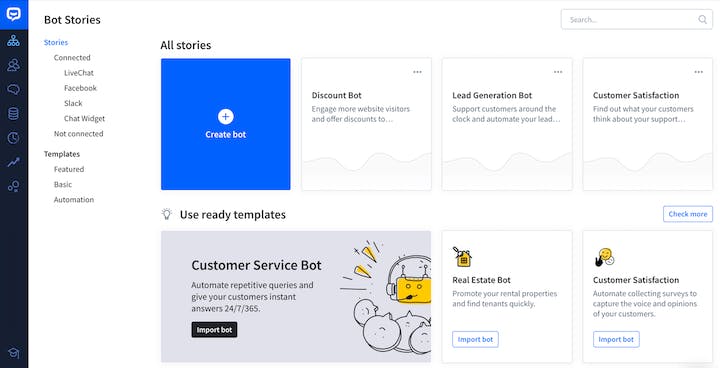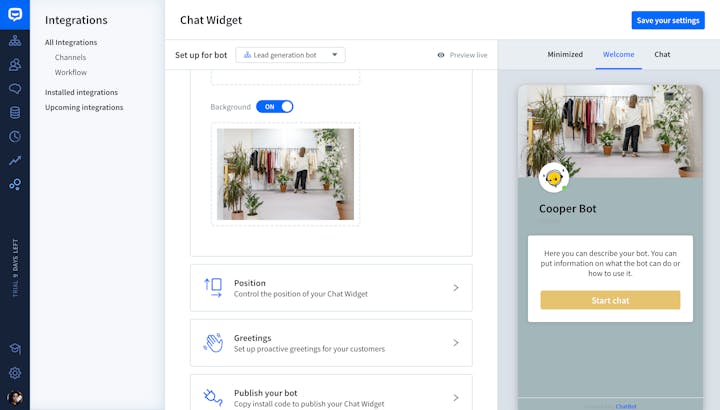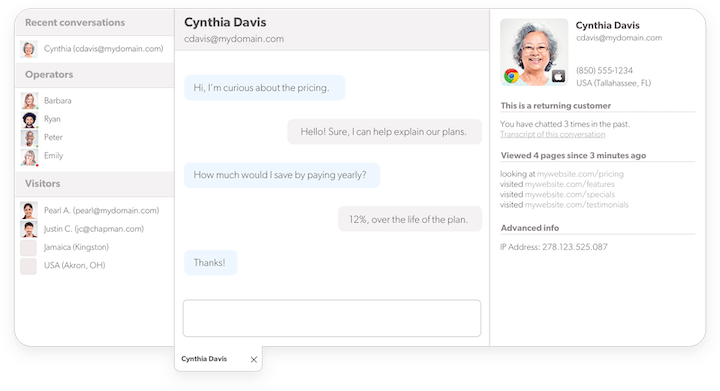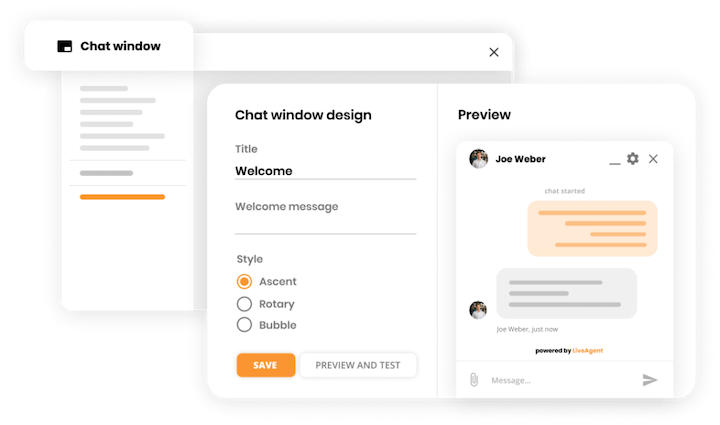9 Best Live Chat Widgets for Your Business


Over the last few years, live chat has emerged as one of the fastest growing support channels. There's a good reason for that: It’s quick, convenient, and cost-effective. It’s what the youths call a “triple threat.”
Customer demand for live chat has continuously increased, making it something teams should consider investing in. If you’re new to the live chat landscape, we’ve got you covered.
In this article, we’ll look at what a live chat widget is, how live chat works, what the benefits are, and some options to consider if you’re ready to add live chat to your support stack.
What is a chat widget?
A chat widget is a small pop-up window on your site where a visitor can start a chat interaction with an agent. You can choose which pages on your site you want a chat widget to display, adding to the overall flexibility of the tool.

How does live chat work?
Though there may be some slight differences between tools, most live chat applications function in the same way.
After embedding the widget on a page, you can choose to set yourself as online, which is when a visitor can start a chat with an agent, or offline, when they won’t be able to start a chat. That said, it’s usually possible for them to submit a support ticket to your team through the widget when you’re offline, which your team can follow up on through email.
From the agent side, when a visitor starts a chat, the agent will generally see a notification of some sort and can choose to start interacting over chat. From there, it plays out much the same as a text conversation would on your phone.
Depending on the tool you use, you can set a limit on the number of chats an agent is able to take at any given time to ensure each customer is getting a great experience. When a chat interaction ends, you generally have a few options:
Close the chat: You both say goodbye and go your separate ways with no further action on either side.
Add a tag or internal note: If your chat tool has analytics capabilities, you might add a tag to keep track of what’s causing visitors to reach out.
Move to another channel: Some issues simply aren’t best handled through chat. In the case something needs more investigation or time to solve, you might move the interaction to a different channel — like email — and follow up from there when you have more information.
Why add live chat support to your website?
Outside of simply being convenient for website visitors, there are three reasons you should consider adding live chat to your site.
People who interact over live chat are more satisfied. Research shows that people who interact over live chat report higher levels of satisfaction when compared to email, phone, and social media support.
Live chat can help increase conversions. One of the most common reasons someone doesn’t complete a purchase is because they’re not able to get an answer to a question they have. With live chat, you can deliver the answers they need and decrease abandoned carts.
It’s more cost-effective than other real-time support options. Even the best phone support person can only handle one call at a time. With live chat, a highly trained agent can handle up to six chats at a time while providing a similar level of service.
The 9 best live chat widgets for your business
If you’re convinced chat is something you’re ready to invest in, here’s a list of nine options for you to consider. There is inherently some feature overlap between tools, but each option has some unique traits that make it better suited for certain teams and use cases.
Help Scout
Best for growing teams.
Help Scout is a complete customer communication platform that empowers teams to interact with customers across a variety of channels, one of which is live chat. You also get access to a shared inbox and a knowledge base builder called Docs.
Help Scout’s live chat product is called Beacon and is included on all plan levels. There aren’t any chat limits with Beacon, and anyone who has a seat in your Help Scout account is able to access it. Beacon lets you add a live chat widget to any page of your choosing.
There are three different styles of widgets you can choose from with Beacon:
Ask first: In ask first mode, the widget is set up so customers are prompted right away to ask their question via chat (if someone is available) or over email.
Neutral: In neutral mode, customers see suggested Docs articles, which you can change to fit the page they’re viewing from. They’re also able to search through all your additional Docs content directly through the widget by entering their search term. If they can’t find the answer they need, they can click on the “ask” button at the top of the widget and submit their question directly to your team.
Self-service: Self-service mode is similar to neutral mode, as it displays articles of your choosing and allows customers to search through additional Docs content directly through the widget. The main difference is there isn’t an “ask” button, meaning customers would need to use a different channel to contact your support team.
All chat interactions are saved in a customer’s profile, making them easy to reference in the future if needed. You also get access to chat-specific analytics through Help Scout’s Reports so you can keep up with demand and keep delivering a great chat experience.
Price: Starting at $20/agent per month.
LiveChat
Best for teams doing chat across multiple channels.

LiveChat is a dedicated chat tool that helps teams deliver a great experience across a number of different chat channels. They accomplish this through an extensive list of over 200 integrations including Shopify, Facebook Messenger, Apple messages, and many more.
LiveChat has a couple of other standout features like the ability to share product cards directly in the chat widget, making it even simpler for customers to make a purchase. You’re also able to set up basic automations to automatically assign chats to get customers the best support quickly.
Price: Starting at $16/agent per month.
HubSpot Service Hub
Best for teams using another HubSpot product.

When most people think of HubSpot, they think of their sales and marketing tools like their CRM. Over the past few years, they’ve developed a customer service tool called Service Hub. Service Hub includes a number of different service tools, including chat.
When a customer starts a chat, agents see a notification in a universal inbox, making those interactions easy to manage. You can also set office hours to let customers know when a live agent is available and even automate routine support interactions by building a basic chatbot.
Last, but certainly not least, if you use HubSpot CRM you’re able to see customer profiles and previous conversation history to have more context when handling customer requests.
Price: Free plan available. Paid plans start at $45/month.
ChatBot
Best for automated support.

Though most of our list is focused on tools that help agents provide live chat support, another great use for a chat widget is offering automated support through chatbots. The aptly named ChatBot is one of the best options on the market.
ChatBot’s no-code software makes creating chatbots a breeze. Through their ChatBot academy, you’re able to learn the ins and outs of the product. If you want to get going even faster, there’s also a large library of prebuilt bots to choose from.
Price: Starting at $42/month.
Sendinblue
Best for basic chat needs.

Sendinblue started out offering email marketing software. As they continue to grow, they’re branching out to other areas of customer communication, one of the most recent ones being chat.
Since chat isn’t their core competency, Sendinblue’s chat product is pretty basic. That said, the install is simple, and you’re able to do things like automatically assign chats to available agents, ensuring chats don’t slip through the cracks.
Price: Free plan available. Paid plans start at $25/month.
Olark
Best for chat-focused teams.

Olark is a dedicated chat tool that empowers teams to deliver live chat support as well as automated chat support through chatbots. Olark also includes a number of productivity features like canned responses to answer frequently asked questions quickly and chat routing to automatically assign new chats.
When you sign up, you also get access to team- and agent-level analytics to better understand overall trends and individual contributions. Olark also offers a number of native integrations with tools like Slack and MailChimp.
Price: Starting at $29/seat per month.
LiveAgent
Best for eCommerce teams.

When LiveAgent first started, they were focused on live chat. Over the years they’ve added more tools like a shared inbox and a knowledge base builder, but they still have a very robust chat tool. Some key features LiveAgent offers are chat-specific analytics, pre-chat forms to offer agents more context for conversations, and real-time typing view to let you see what someone is typing before they hit send, helping you deliver great service that much faster.
LiveAgent is also optimized for mobile devices, so customers are comfortable contacting you no matter what device they’re on. If you run an eCommerce store, LiveAgent has integrations with many of the top eCommerce platforms like Shopify, Magento, and Prestashop.
Price: Starting at $15/agent per month.
Chaport
Best for self-service.

Chaport is a customer support tool that offers solutions for live and self-service support. With Chaport you’re able to add a live chat widget to your site as well as build out chatbots for automated support. You’re also able to connect to a number of messaging apps like Facebook Messenger and Viber to keep all your chat interactions in one place.
Chaport also offers knowledge base building software, which you can connect to your chat widget to suggest articles to customers to deliver quick support while reducing requests for your live staff. However, you can only get access to that functionality on Chaport’s highest-cost plan.
Price: Free plan available. Paid plans start at $19/month.
Intercom
Best for proactive messaging.

Intercom is all about engaging with customers. The main way they do that is through a variety of chat widgets, including three main types. One is a chatbot to help with automated answers, another is for in-app messaging to communicate with customers proactively, and the last one is for live chat services to provide real-time support.
Looking at Intercom’s features, it’s clear they have a higher focus on using chat for marketing and sales. For example, you’re able to set up push notifications and A/B test copy for pop-up messages. They also have some support-focused features like SLAs and team inboxes.
Price: Contact Intercom for pricing.
Moving forward
Picking the right live chat tool comes down to what your specific needs are. Once you have a good idea of how you’ll use the tool, take the time to test out a couple of options. Having that firsthand experience can help making a decision easier if two tools are equal on paper.
You should also check out their training resources and consider sending a ticket to their support team. Even the most tech-savvy users need help from time to time, so knowing what level of support you’ll have is always good. If you still want a little more guidance in the process, check out our Buyer’s Guide to Choosing the Right Customer Support Tool.